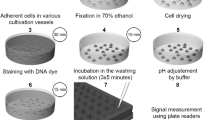Summary
The Romanowsky-Giemsa staining (RG staining) has been studied by means of microspectrophotometry using various staining conditions. As cell material we employed in our model experiments mouse fibroblasts, LM cells. They show a distinct Romanowsky-Giemsa staining pattern. The RG staining was performed with the chemical pure dye stuffs azure B and eosin Y. In addition we stained the cells separately with azure B or eosin Y. Staining parameters were pH value, dye concentration, staining time etc. Besides normal LM cells we also studied cells after RNA or DNA digestion. The spectra of the various cell species were measured with a self constructed microspectrophotometer by photon counting technique. The optical ray pass and the diagramm of electronics are briefly discussed.
The nucleus of RG stained LM cells, pH≃7, is purple, the cytoplasm blue. After DNA or RNA digestion the purple respectively blue coloration in the nucleus or the cytoplasm completely disappeares. Therefore DNA and RNA are the preferentially stained biological substrates.
In the spectrum of RG stained nuclei, pH≃7, three absorption bands are distinguishable: They are A1 (15400 cm−1, 649 nm), A2 (16800 cm−1, 595 nm) the absorption bands of DNA-bound monomers and dimers of azure B and RB (18100 cm−1, 552 nm) the distinct intense Romanowsky band. Our extensive experimental material shows clearly that RB is produced by a complex of DNA, higher polymers of azure B (degree of assoziation p>2) and eosin Y. The complex is primarily held together by electrostatic interaction: Binding of polymer azure B cations to the polyanion DNA generates positively charged binding sites in the DNA-azure B complex which are subsequently occupied by eosin Y anions. It can be spectroscopically shown that the electronic states of the azure B polymers and the attached eosin Y interact. By this interaction the absorption of eosin Y is red shifted and of the azure B polymers blue shifted. The absorption bands of both moleculare species overlap and generate the Romanowsky band. Its strong maximum at 18100 cm−1 is due to the cosin Y part of the DNA-azure B-eosin Y complex. The discussed red shift of the eosin Y absorption is the main reason for the purple coloration of RG stained nuclei.
Using a special technique it was possible to prepare an artificial DNA-azure B-eosin Y complex with calf thymus DNA as a model nucleic acid and the two dye stuffs azure B and eosin Y. Its absorption spectrum is identical with the spectrum of Romanowsky stained nuclei. This experiment demonstrates that the whole Romanowsky-Giemsa staining pattern of the nucleus is primarily produced by DNA, azure B and eosin Y.
The spectrum of RG stained cytoplasm, pH≃7, consists of three absorption bands A1′ (15300 cm−1, 654 nm), A2′ (16900 cm−1, 592 nm), A3′ (17600 cm−1, 568 nm). They are attributed to monomers, dimers and polymers of azure B bound to RNA. In general A2′ and A3′ overlap strongly and generate a broad absorption band A′ (∼17000 cm−1, 588 nm). Some experimental results can be interpreted in terms of a RNA-azure B-eosin Y complex in the cytoplasm. But its concentration must be very small.
Variations in the biological materials and the experimental staining conditions may alter the position and the intensity of the absorption bands but does not change the underlying molecular concept of the Romanowsky-Giemsa effect.
Similar content being viewed by others
Literatur
Fajans H, Hassel O (1923) Eine neue Methode zur Titration von Silber- und Halogenionen mit organischen Farbstoffindikatoren. Z Elektrochem 29:495–500
Feulgen R, (1913) Das Verhalten der echten Nucleinsäure zu Farbstoffen. Hoppe Seylers Z physiol Chem 84:309–328
Förster Th, König E (1957) Absorptionsspektren und Fluoreszenzeigenschaften konzentrierter Lösungen organischer Farbstoffe. Z Elektrochem 61:344–348
Galbraith W, Marshall PN, Bacus IW (1980) Microspectrophotometric studies of Romanowsky stained blood cells. I. Substraction analysis of a standardized procedure. J Microsc 119:313–330
Kalousek I, Jandrova D, Vodrazka Z (1980) Electrostatic interactions of fluorescein dyes with proteins. Int J Biol Macromol 2:284–288
Lapen D (1982) A standardized differential stain for haematology. Cytometry 2:309–315
Marshall PN, Galbraith W, Navarro EF, Bacus IW (1981) Microspektrophotometric studies of Romanowsky stained blood cells. II. Comparison of the performance of two standardized stains. J Microsc 124:197–210
Müller R, Zimmermann HW (1983) Private Mitteilung
Wittekind D (1979) On the nature of Romanowsky dyes and Romanowsky Giemsa effect. Clin Lab Haematol 1:247–262
Wittekind D (1980) Färbungen in der Haematologie und ihre Beiträge zur Kenntnis der Morphologie des Bluts und der blutbildenden Organe. Verh Anat Ges 74:183–201
Wittekind D, Kretschmer V, Löhr W (1976) Kann Azur B-Eosin die May-Grünwald-Giemsa-Färbung ersetzen. Blut 32:71–78
Wittekind D, Kretschmer V, Sohmer I (1982) Azur B-eosin Y stain as the standard Romanowsky Giemsa stain. Br J Haematol 51:391–393
Wittekind DH (1983) On the nature of the Romanowsky Giemsa staining and its significance for cytochemistry and histochemistry: an overall view. Histochem J 15:1029–1047
Wittekind DH, Gehring T (1984) On the nature of Romanowsky-Giemsa staining and the Romanowsky-Giemsa-effect: I. Model experiments on the specifity of azure B — eosin Y stain as compared with other thiazine dye — eosin Y combinations. Histochem J (im Druck)
Zipfel E, Grezes JR, Seiffert W, Zimmermann HW (1981) Über Romanowsky-Farbstoffe und den Romanowsky-Giemsa-Effekt. 1. Mitteilung: Azur B, Reinheit und Gehalt von Farbstoffen, Assoziation. Histochemistry 72:279–290
Zipfel E, Grezes JR, Seiffert W, Zimmermann HW (1982) Über Romanowsky-Farbstoffe und den Romanowsky-Giemsa-Effekt. 2. Mitteilung: Eosin Y, Erythrosin B, Tetrachlorfluorescein. Spektroskopische Charakterisierung der reinen Farbstoffe, Assoziation von Eosin Y. Histochemistry 75:539–555
Zimmermann H (1983) Physikalisch-chemische Grundlagen der Färbung für manuelle und apparative Zytodiagnostik. Microsc Acta (Suppl) 6:45–58
Author information
Authors and Affiliations
Rights and permissions
About this article
Cite this article
Zipfel, E., Grezes, J.R., Naujok, A. et al. Über Romanowsky-Farbstoffe und den Romanowsky-Giemsa-Effekt. Histochemistry 81, 337–351 (1984). https://doi.org/10.1007/BF00514328
Accepted:
Issue Date:
DOI: https://doi.org/10.1007/BF00514328




